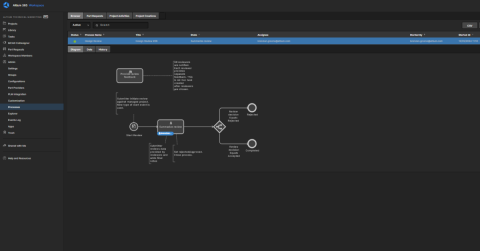Component Templates and the Manufacturer Part Search Panel
Summary:
This video demonstrates how to take advantage of component templates to bring components into your managed library in Altium 365, as well as using the Manufacturer Part Search Panel. Component templates allow Altium 365 users to create specific settings or requirements in your library resources, thus streamlining the creation of components, or the process of retrieving them from the Manufacturer Part Search Panel.
The video begins by opening the components template for capacitors and discussing the predefined symbols and parameters which are brought in for each new component. Then, the video imports a wireless IC from the Manufacturer Part Search to the workspace and discusses the features of this panel.
Lastly, the video discusses how to enable or disable component template parameters. Thus, by implementing component templates into a workflow, users can streamline component creation in Altium 365.
Transcript:
00:00:00:00 - 00:00:24:10
Hello. In this video, we'll take a look at working with the Manufacturer Part Search Panel. Specifically, we'll take a look at taking advantage of component templates within Altium 365 to bring in components to your managed library on Altium 365 that are already pretty much ready to go. So let's take a look at the Manufacturer Parts Search. But first I want to take a look at component templates.
00:00:24:11 - 00:01:01:02
Explain a little bit about those and how they're going to help you. Altium 365 provides the ability for you to have component templates put in place. Now, these component templates will allow you to go ahead and have specific settings, specific needs, and requirements that are already defined in your library resources set up and ready to go. So as you're creating components or in this instance, bringing them in from your Manufacturer Part Search Panel, they're already bringing in the information that you need or at least as much of that as you can get in the Explorer Panel.
00:01:01:04 - 00:01:23:07
You can find your components templates by going to Manage Content, templates, and then component template section. Here we'll take a look at a couple of different templates to give you an idea of what component templates can do. Let's take a look at a very common discrete or common component type, which is capacitors. I'm going to choose to edit this so you can see what it looks like.
00:01:23:08 - 00:01:49:13
Now as you'll see in the component template, I've already predefined a symbol that will be used any time I create a new component with a component type of template. This helps me to not have to go search for this specific model or have to try to recreate it from scratch every time. Additionally, I've defined a set of parameters that are already required for me to be able to put into the component as well.
00:01:49:14 - 00:02:20:02
As long as I can find that information or provide it. So we're making sure that every parameter that's necessary for our design process and down line is available with the component as it's being created. And used now there are other settings that you could go into, such as marking specific parameters as required so that the component cannot be created using this component template and finalized or released until that particular parameter or piece of information is provided.
00:02:20:03 - 00:02:41:11
You can also see you could define things such as your life cycle, default component name schemes, where these components would be stored in the explorer panel, and even a revision naming schemes, one level, two level, three level, and so on. So we'll leave this as is, but I wanted you to know that you can define specific models, such as your symbol or even a default footprint.
00:02:41:12 - 00:03:12:07
And then I have other parameters available based on that component type. So for instance, if I was to close this out and I go look at, let's say, you know, ICs or wireless IC for instance, click on edit. You'll see that my parameters are a little bit different, different types, different pieces of information. So there are different ways to manage each particular component site and that template be applied to that component type.
00:03:12:08 - 00:03:36:00
So this is where the benefit comes in. So as I'm creating a new component just from scratch right from the beginning, it'll ask me if I want to go ahead and create a new component and what component type I want to create, so it knows which template to apply to it. Now how this will help you in the Manufacturer Part Search Panel is when I'm doing the same thing I'm bringing in a component.
00:03:36:00 - 00:03:58:13
It's going to ask me for component type. So for instance, let's say I wanted to bring in a wireless chip or module that we were looking at earlier. In a manufacturer part search you can search by term, manufacturer part numbers, comments, details, things like that. So I've searched wireless and as you can see there's a few that have come up here.
00:03:58:14 - 00:04:23:14
Ideally, in a manufacturer part search, green is good. So I got green chips, which means it's got a symbol and a footprint. I got a green line, which means the supply is probably pretty good, and then I've got six supply manufacturers or suppliers that I can pull from. So I like this part. Let me go ahead and work on acquiring it. Now prior to acquiring it, if I wanted to confirm it's got some information that I need or what I could click here to expand that.
00:04:24:00 - 00:04:48:14
And here's all the information that will be provided with this component as I bring it in. Now I want you to note the amount of information that is available to me. So when I go to actually bring this into my workspace by right clicking, choosing save to my workspace, navigating to integrated circuits and wireless; you'll note that it's going to take a look at the component information based on a component template and what's available.
00:04:49:00 - 00:05:11:13
So if it was in my component template, everything that's white is something that the information is able to be provided as I'm bringing this component information in to my library. These are parameters that were already defined in my template. So you’ll note that's why it's updating those specific fields. So instead of it being blank, they'll actually be updated to have information.
00:05:11:14 - 00:05:30:05
The red items are pieces of information that, as you'll know, were available with the component but aren't in my template. So I could choose to use this information, or I could choose to leave it out. It's entirely up to me. I can enable them one by one, or if I want to just bring everything in, make sure I have all the information available to me.
00:05:30:07 - 00:05:50:00
I could disable this option to turn everything off, and then turn it back on it to bring everything in. Now you'll note what it's going to also do is add the parameter with the set name and the information that's being provided with those parameters. So for now I'm going to go back. I'm going to cancel this. I going to reapply it.
00:05:50:01 - 00:06:00:05
But this time I'm only going to bring in the template information.
00:06:00:06 - 00:06:28:12
I could also make sure that if I want to hide everything and just show what's available by template, turn on show only matching with template. And this is all the information that was in my template as parameters I wanted to bring in. So I'll click okay. Now time saves here. Obviously having to recreate the symbol from scratch, drawing out the footprint linking those components together, creating the parameters from scratch, bringing those in as well.
00:06:28:13 - 00:06:41:03
So a lot of that's already done right away. So that's how a component template can really save me a ton of time in creating my components. I hope this video has been helpful and we'll see you in the next video.



